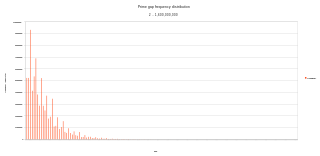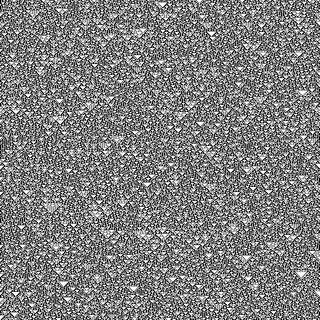
A prime number is a natural number greater than 1 that is not a product of two smaller natural numbers. A natural number greater than 1 that is not prime is called a composite number. For example, 5 is prime because the only ways of writing it as a product, 1 × 5 or 5 × 1, involve 5 itself. However, 4 is composite because it is a product (2 × 2) in which both numbers are smaller than 4. Primes are central in number theory because of the fundamental theorem of arithmetic: every natural number greater than 1 is either a prime itself or can be factorized as a product of primes that is unique up to their order.
The Collatz conjecture is one of the most famous unsolved problems in mathematics. The conjecture asks whether repeating two simple arithmetic operations will eventually transform every positive integer into 1. It concerns sequences of integers in which each term is obtained from the previous term as follows: if the previous term is even, the next term is one half of the previous term. If the previous term is odd, the next term is 3 times the previous term plus 1. The conjecture is that these sequences always reach 1, no matter which positive integer is chosen to start the sequence.
A twin prime is a prime number that is either 2 less or 2 more than another prime number—for example, either member of the twin prime pair or (41, 43). In other words, a twin prime is a prime that has a prime gap of two. Sometimes the term twin prime is used for a pair of twin primes; an alternative name for this is prime twin or prime pair.
In mathematics, a Fermat number, named after Pierre de Fermat, the first known to have studied them, is a positive integer of the form
In number theory, Dirichlet's theorem, also called the Dirichlet prime number theorem, states that for any two positive coprime integers a and d, there are infinitely many primes of the form a + nd, where n is also a positive integer. In other words, there are infinitely many primes that are congruent to a modulo d. The numbers of the form a + nd form an arithmetic progression
In number theory, a Sierpiński number is an odd natural number k such that is composite for all natural numbers n. In 1960, Wacław Sierpiński proved that there are infinitely many odd integers k which have this property.
In number theory, Cramér's conjecture, formulated by the Swedish mathematician Harald Cramér in 1936, is an estimate for the size of gaps between consecutive prime numbers: intuitively, that gaps between consecutive primes are always small, and the conjecture quantifies asymptotically just how small they must be. It states that
In mathematics, a Cullen number is a member of the integer sequence . Cullen numbers were first studied by James Cullen in 1905. The numbers are special cases of Proth numbers.
In mathematics, a Riesel number is an odd natural number k for which is composite for all natural numbers n. In other words, when k is a Riesel number, all members of the following set are composite:
A powerful number is a positive integer m such that for every prime number p dividing m, p2 also divides m. Equivalently, a powerful number is the product of a square and a cube, that is, a number m of the form m = a2b3, where a and b are positive integers. Powerful numbers are also known as squareful, square-full, or 2-full. Paul Erdős and George Szekeres studied such numbers and Solomon W. Golomb named such numbers powerful.
In number theory, Polignac's conjecture was made by Alphonse de Polignac in 1849 and states:

In number theory, a polite number is a positive integer that can be written as the sum of two or more consecutive positive integers. A positive integer which is not polite is called impolite. The impolite numbers are exactly the powers of two, and the polite numbers are the natural numbers that are not powers of two.

A prime gap is the difference between two successive prime numbers. The n-th prime gap, denoted gn or g(pn) is the difference between the (n + 1)-st and the n-th prime numbers, i.e.
François Proth was a French self-taught mathematician farmer who lived in Vaux-devant-Damloup near Verdun, France.
In mathematics, the Lucas–Lehmer–Riesel test is a primality test for numbers of the form N = k ⋅ 2n − 1 with odd k < 2n. The test was developed by Hans Riesel and it is based on the Lucas–Lehmer primality test. It is the fastest deterministic algorithm known for numbers of that form. For numbers of the form N = k ⋅ 2n + 1, either application of Proth's theorem or one of the deterministic proofs described in Brillhart–Lehmer–Selfridge 1975 are used.

In the mathematical study of cellular automata, Rule 90 is an elementary cellular automaton based on the exclusive or function. It consists of a one-dimensional array of cells, each of which can hold either a 0 or a 1 value. In each time step all values are simultaneously replaced by the exclusive or of their two neighboring values. Martin, Odlyzko & Wolfram (1984) call it "the simplest non-trivial cellular automaton", and it is described extensively in Stephen Wolfram's 2002 book A New Kind of Science.
In mathematics, the three-gap theorem, three-distance theorem, or Steinhaus conjecture states that if one places n points on a circle, at angles of θ, 2θ, 3θ, ... from the starting point, then there will be at most three distinct distances between pairs of points in adjacent positions around the circle. When there are three distances, the largest of the three always equals the sum of the other two. Unless θ is a rational multiple of π, there will also be at least two distinct distances.
A Proth number is a natural number N of the form where k and n are positive integers, k is odd and . A Proth prime is a Proth number that is prime. They are named after the French mathematician François Proth. The first few Proth primes are
Norman Laurence Gilbreath is an American magician and author known for originating the Gilbreath shuffle. He is also known for Gilbreath's conjecture concerning prime numbers.













